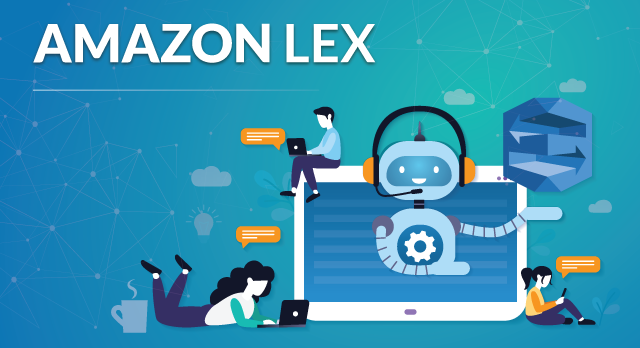What is Amazon Lex?

Amazon Lex is a conversational AI service that allows you to build chatbots that can interact with your customers using natural language. It uses the same technology as Amazon's Alexa, allowing you to create bots that can understand and respond to spoken or written language.
How Does Amazon Lex Work?
Amazon Lex is a service for building conversational interfaces. It enables you to build applications that use voice and text to have natural conversations with your customers.
With Amazon Lex, you can create chatbots or voice-enabled digital assistants that make it easy for customers to complete tasks on your website such as ordering products, checking the status of an order or finding out more about a product.
Amazon Lex provides Natural Language Understanding (NLU) so that you can build Alexa skills in any language and deploy those skills across multiple devices including mobile phones, speakers like Amazon Echo Dot and Echo Show devices.
Benefits of Amazon Lex
1. Cost-Effective

One of the best things about Amazon Lex is that it makes building chatbots easy and cheap. Amazon Lex is a pay-per-use service, which means that businesses only pay for the time their chatbots are active. This makes it a good choice for businesses of all sizes because it is affordable.
2. Scalability
Amazon Lex is a solution that can handle a large number of customer questions and is easy to scale. As the number of customer questions goes up, Amazon Lex can automatically scale up to handle the extra work without any extra resources or setup.
3. Better interaction with customers
By building chatbots with Amazon Lex, businesses can make customers more engaged and happy. Chatbots can give instant answers to common questions and help with simple problems, which frees up human agents to deal with more complicated questions. This makes the customer experience better overall and makes customers more loyal.
4. Integration with other services offered by AWS
Amazon Lex works with Amazon S3, Amazon Lambda, and Amazon DynamoDB, among other AWS services. This makes it easy for businesses to make a full chatbot solution that can store and retrieve data, run code, and handle complex workflows.
5. Natural Language Processing
Amazon Lex uses NLP to understand customer requests and figure out what they mean. This lets chatbots talk to customers in a way that seems natural and human. This makes it easier for customers to get the information they need. NLP also lets chatbots learn from how customers talk to them, making their answers more accurate and useful over time.
Use Cases of Amazon Lex
1. Customer Service Chatbots
Amazon Lex enables the creation of AI-powered chatbots, which can handle various customer service tasks such as answering FAQs, assisting with order tracking, or troubleshooting issues. These chatbots provide 24/7 support, reduce response times, and free up human agents for more complex tasks.
2. Virtual Assistants

Amazon Lex facilitates the development of virtual assistants for websites, mobile apps, or IoT devices, streamlining tasks such as appointment scheduling, reminders, or providing personalized recommendations. These tailored experiences improve user engagement and satisfaction.
3. Contact Center Automation
Integrating Amazon Lex with contact center platforms enables seamless automation of routine tasks such as call routing, first-level support, or customer data collection. This improves call center efficiency, reduces costs, and enhances the overall customer experience.
4. Voice User Interface (VUI) Integration
Amazon Lex's natural language understanding (NLU) and speech recognition capabilities allow developers to create engaging voice user interfaces for their applications. This includes voice-activated commands, voice-based searches, and interactive voice response (IVR) systems for a hands-free user experience.
5. Enterprise Productivity Solutions
By incorporating Amazon Lex into enterprise applications, organizations can automate tasks such as employee onboarding, IT helpdesk support, or internal knowledge base queries. This reduces manual processes, increases productivity, and improves employee satisfaction.
Key Concepts in Amazon Lex
1. Intents
Intents are the core of any Amazon Lex conversation. They represent the actions that users want to perform with the chatbot or application. Intents help Lex understand the user's purpose, making it possible for the chatbot to provide relevant and accurate responses.
2. Utterances
Utterances are the phrases and sentences that users input during a conversation with a Lex chatbot. These expressions help Amazon Lex recognize the user's intent. Utterances can vary in format and structure, so it's essential to have a diverse set of examples during the chatbot's development to ensure a comprehensive understanding of user requests.
3. Slots
Slots are placeholders for pieces of information that users must provide to fulfill their intent. They act as variables that capture specific data from user utterances, such as dates, names, or product preferences. This information enables Lex chatbots to deliver personalized responses and complete user requests efficiently.
4. Fulfillment
Fulfillment is the process of completing a user's request and providing the desired output or action. In Amazon Lex, fulfillment can be achieved using AWS Lambda functions or by returning parameters to the client for further processing. This ensures that the chatbot can execute complex tasks or integrate with external systems to deliver the appropriate response.
5. Prompting and Confirmation
Prompting and confirmation are essential elements of a conversational interface in Amazon Lex. They enable the chatbot to request additional information or clarify user requests when necessary. Prompting helps gather missing or incomplete data, while confirmation ensures that the chatbot has accurately understood the user's intent before proceeding with an action. Both play a crucial role in delivering a smooth and engaging user experience.
Building Chatbots with Amazon Lex
1. Creating a Bot
To create a bot with Amazon Lex, you first need to create a new bot in the Amazon Lex console. This involves giving your bot a name, a description, and choosing a language. You can then define the intents and slots that your bot will use to interact with users.
2. Adding Intents and Slots
Once you have created your bot, you can start adding intents and slots. For each intent, you define the sample phrases that the bot should recognize, as well as the slots that it needs to fill. You can also define prompts to ask the user for missing information, and validation rules to ensure that the user input is correct.
For example, let's say you are building a bot for a pizza restaurant. You might create an intent called "OrderPizza" and define sample phrases like "I'd like to order a pizza with pepperoni" or "Can I get a large pizza with mushrooms?". You would then define slots for toppings, size, and delivery address.
For the toppings slot, you might include a list of options like pepperoni, mushrooms, or olives. For the delivery address slot, you might require the user to provide a valid address in a specific format.
3. Testing the Bot
After you have defined your intents and slots, you can test your bot using the built-in Amazon Lex chat interface. This allows you to enter sample phrases and see how your bot responds. You can also use the test console to see the JSON output from your bot, which can be useful for debugging.
When testing your bot, it's important to try a variety of inputs to ensure that it is working correctly. You should also consider edge cases and unexpected inputs to make sure that your bot can handle them gracefully.
Future scope for Amazon Lex
1. Expanding Language Support
As Amazon Lex continues to advance, it is expected that the platform will broaden its language support to cater to a more diverse range of users. This expansion will allow businesses and developers to create chatbots and voice assistants that can communicate effectively with customers from different linguistic backgrounds, enhancing global reach and user experience.
2. Integration with More Platforms and Services
Future developments in Amazon Lex may involve seamless integration with a wider variety of platforms and services. This will enable developers to build chatbots and voice assistants that can easily utilize features from other platforms, such as social media, CRM systems, or data analytics tools. The result will be more versatile and efficient bots, capable of delivering personalized experiences for users.
3. Enhanced Machine Learning Capabilities
As machine learning technology continues to evolve, the potential for Amazon Lex to learn and adapt according to user interactions will increase. This will lead to smarter chatbots and voice assistants that can better understand and respond to user queries with greater accuracy. Additionally, these advancements in machine learning may also enable bots to predict user needs proactively, making interactions more intuitive and satisfying.
4. Improved Voice and Speech Recognition
With the rapid advancements in voice and speech recognition technologies, Amazon Lex is likely to benefit from these developments. As the platform's voice and speech recognition capabilities improve, users can expect more natural-sounding and accurate interactions with their chatbots and voice assistants. This will not only enhance user experience but also contribute to the widespread adoption of voice technology in various industries.
5. Greater Focus on Security and Privacy
As the use of chatbots and voice assistants becomes increasingly prevalent, the need for robust security measures and user privacy protection will be paramount. Amazon Lex is likely to enhance its security features and privacy policies, ensuring that user data is safeguarded effectively. This emphasis on security will build trust among users and encourage the further adoption of Amazon Lex in industries that handle sensitive information.
FAQs
1. What is Amazon Lex?
Amazon Lex is an AWS service for building conversational interfaces, like chatbots and voice assistants, using natural language understanding (NLU) and speech recognition.
2. How does Amazon Lex work?
Amazon Lex uses machine learning to understand user input, identify intents, and provide appropriate responses or actions based on the defined conversation flow.
3. What are the key features of Amazon Lex?
Key features include natural language understanding, automatic speech recognition, pre-built chatbot templates, and integration with AWS and third-party services.
4. Can I use Amazon Lex for multiple languages?
Yes, Amazon Lex supports multiple languages, including English, Spanish, French, Italian, German, and Brazilian Portuguese.
5. How much does Amazon Lex cost?
Amazon Lex has a pay-as-you-go pricing model, charging based on the number of text or voice requests processed. You can find detailed pricing on the AWS website.

